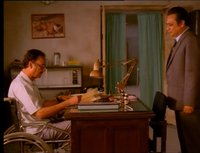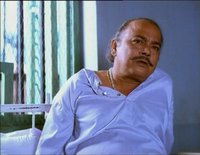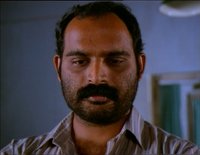“Wheel Chair” is a 1995 Bollywood movie, minus much of the singing and dancing, available on Netflix in the Bengali language with English subtitles. Susmita, a typist, is working late one night when three men attack her in the stairwell with the intent to rape her, causing her to fall and break her neck. Someone calls an ambulance, and the doctors at the hospital she’s taken to decline to do surgery (presumably to stabilize her neck) for fear of affecting the “Vegas” nerve. (Surely they mean vagus. One would hope that a doctor has a good grasp of geography; after all, they’d better know how to locate the islets of Langerhaans.)
Susmita’s head is put into a primitive Hannibal Lechter-type headgear that doesn’t look terribly stable, ostensibly to provide traction. The company Susmita worked for takes responsibility for paying for her care and rehabilitation, and she is brought into the care of Dr. Mitra, who runs a home for “neurological disabilities” and is also a paraplegic himself.
Dr. Mitra acquired his disability in a car accident in England on his way to a neurology conference, and “somehow found his way” back to India. (It is fortunate that he became a neurologist before becoming disabled, as people with disabilities who want to enter the medical profession often face obstacles and prejudice from medical schools.) The small clinic/home he founded in Calcutta has lost its funding from the government, and the board of directors wants to sell the land to put up a nursing home. Dr. Mitra must balance his time between treating patients, fighting with his own board of directors, and cajoling money from businessmen to keep the home running and the patients fed. He is portrayed as being a professional inspiration to his patients, yet privately he drinks, relies on the assistance of the able-bodied staff for tasks a paraplegic can usually do by themselves, and occasionally wishes out loud for death just as his patients constantly do.
Susmita is wheeled in on a gurney through the men’s ward, where she is frightened by the ogling of the male residents. They are introduced as Nantu, a young man who has been disabled from birth (probably from cerebral palsy, although he’s being treated with Vitamin B):
Mr. Shatadal, a belligerent older man on crutches who fantasizes about dying and being taken away by a white camel with a golden saddle blanket:
and Amin, a tall, withdrawn, intimidating man who was an astrophysicist before he had a nervous breakdown.
The handsome physical therapist Santu sets to work on the depressed Susmita, who agrees to work at therapy only to regain use of her hands and arms to kill herself. He stretches her limbs and painfully puts her face-down in a hammock when a bedsore begins. One night, against the orders of Dr. Mitra, Santu engages in what he calls “shock therapy”; he slides his hand up Susmita’s thigh under her clothing in order to deliberately remind her of the rape. In a panic, she moves a toe. This is hailed as a breakthrough instead of a violation of professional boundaries, and it fulfills the Disability Movie Cliche and ludicrous ableist conceit that disabled people can be cured by attention from the opposite sex.
The most realistic aspect of the movie Wheel Chair is the agonizingly slow pace of recovery for each resident. By the time Susmita is ready to return home two years after arrival, Nantu has progressed from learning his letters to slow reading (though everyone discourages him from hope of ever having a wife). Amin has displayed anger over conditions in the home, pushing Dr. Mitra over and then returning him to his wheelchair, and later writing an inscrutable equation on a slate. Mr. Shatadal reveals himself to be a self-made man from selling nuts and bolts to the American army at a huge markup, writes a large check to the home, and then suddenly goes blind and dies within minutes.
After Susmita returns to her mother’s home to begin a prescribed regimen of physical therapy and slow hunt-and-peck typing, Santu asks Dr. Mitra of the advisability of marrying her. Dr. Mitra assures him that she will be able to bear children, so Santu declares to Sumitra’s mother that he wants to “take on full responsibility” for her. Susmita is in tears at this… charming proposal, but though she ascribes to the common belief one must be able-bodied to be married she eventually acquiesces, saying that she’ll put down the returning strength of her upper body as capital and work for the rest. Santu and Susmita settle down into a house on a river, where Santu is last seen happily carrying Susmita to a wheelchair on a patio.





Just wanted to say that not all Indian movies are Bollywood movies. A Bengali movie is something different. Good find, though! I hadn’t heard about this one.